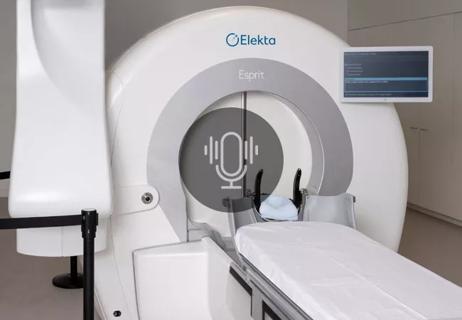Meta-analysis suggests efficacy and safety

Preoperative, ultra-hypofractionated radiotherapy (RT) for soft tissue sarcoma (STS) offers patients excellent two-year local control and complication rates similar to the current standard of care, according to a new meta-analysis from Cleveland Clinic researchers. They presented their findings at the American Society for Radiation Oncology (ASTRO) 65th annual meeting.
Advertisement
Cleveland Clinic is a non-profit academic medical center. Advertising on our site helps support our mission. We do not endorse non-Cleveland Clinic products or services. Policy
“Right now, the standard of care for intermediate to high-grade soft tissue sarcoma involves surgery with conventional radiotherapy before or afterwards, with patients typically receiving preoperative 50 Gy in 25 treatment sessions,” says Zachary Mayo, MD, a senior radiation oncology resident and first author of the study. “As treatments for other cancers have moved toward shorter courses, we’ve seen a growing interest in doing so for soft tissue sarcomas as well.”
Several studies in the literature evaluate the safety and efficacy of delivering RT over shorter treatment courses for patients with STS, including 5-fraction ultra-hypofractionated RT (25-40 Gy/5 treatments); however, these are small, single institution experiences with fewer than 50 patients in each study. Cleveland Clinic researchers sought to gain a broader perspective on the efficacy and safety of this delivery technique through a meta-analysis of currently published literature with subgroup analysis of total dose delivered.
Researchers queried medical research databases for potential studies to include, and seven studies met the inclusion criteria of STS of the extremity or trunk treated with 5-fraction preoperative RT, with a fraction size of ≥ 5 Gy per fraction. Studies must have reported two-year local control rates and major wound complications as well.
For the entire cohort, two-year local control was 96.9% (95% highest posterior density [HPD]: 0.93-0.98). The rate of major wound complications was 30.6% (95% HPD: 0.21-0.41), a rate similar to historical studies of conventionally fractionated radiotherapy. Of the 208 patients included in the meta-analysis, 144 received ≥ 30 Gy. There was a trend towards improved local control in patients receiving higher doses of RT.
Advertisement
Acute and late toxicity rates were also similar to historical studies, with acute toxicity of grade 2 dermatitis at 12.7% and late toxicity of grade 2 fibrosis at 11.1%, grade 2 stiffness at 6.0% and grade 2 lymphedema at 4.0%.
“Because soft tissue sarcoma is rare, this meta-analysis allows us to look at a larger patient cohort for indications of whether this investigational approach is working,” says Dr. Mayo. “The next step is a multi-institutional trial with universal RT protocols and a much larger sample size.”
Studies like this one are supporting a shift in the paradigm of treating soft tissue sarcomas from long courses of preoperative RT to short courses of hypo- and ultra-hypofractionated RT that have been used successfully in breast and prostate cancers.
Cleveland Clinic has been treating select patients with extremity STS with ultra-hypofractionated RT for about six years. Patients deemed to be candidates for this treatment regimen following multidisciplinary sarcoma tumor board discussion receive five fractions over the course of five days.
“The ultra-hypofractionated approach allows patients to complete treatment in a much shorter interval than the standard five weeks that is typical under the current standard of care,” says Shauna Campbell, DO, of the Department of Radiation Oncology at Cleveland Clinic, and senior author of the study. “This approach potentially reduces the financial and psychosocial stressors patients face with longer courses of RT, and the results of our meta-analysis indicate this approach is safe and effective. We are looking forward to validating these results with a multi-institutional study.”
Advertisement
Learn more in our podcast with Dr. Shauna Campbell.
Advertisement
Advertisement

This rare disease usually manifests as a firm, painless mass that is growing

An update on the technology from the busiest Gamma Knife center in the Americas

Machine learning models assess intraoperative tissue perfusion

Radiation oncology department finds weekly plan of care meetings have multiple benefits

Daily five-fraction partial breast irradiation (PBI) shows similar acute and late toxicity as every other day PBI

Research highlights promising outcomes for treating recurrent and metastatic cases

Approach could help clinicians identify patients at an increased risk of progression who could benefit from more aggressive treatment

Improvements enable targeting of brain tumors with single-session, fractionated or neoadjuvant approaches